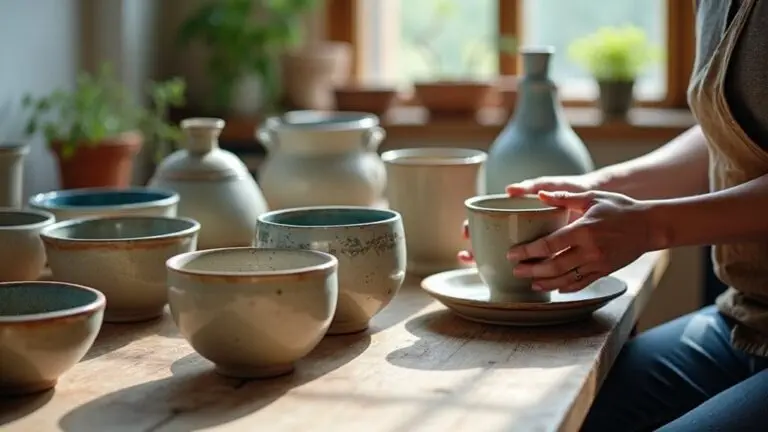When pricing your handmade pottery, you'll need to factor in several key elements: materials (about $0.50 per pound for clay and $2 per pound for glaze), your time (skilled potters charge $25-75 per hour), and overhead costs like kiln maintenance and utilities ($200-500 monthly). Start by calculating your base costs, then double that amount for your initial markup. Most handmade pottery pieces sell between $20-100, depending on size, complexity, and market demand. Consider your sales channels too – galleries take 30-60% commission, while online platforms have their own fees. There's quite a bit more to mastering your pottery pricing strategy, but these fundamentals will get you started.
Understanding Your Production Costs

When starting a pottery business, understanding your production costs is essential to setting sustainable prices.
You'll need to create a detailed cost breakdown that includes everything from your initial studio setup to ongoing expenses. Whether you're renting a modest space or investing in your own studio, you're looking at significant startup costs ranging from $2,500 to $250,000 or more. Each piece requires extensive time investment for proper completion.
To boost your production efficiency, carefully track the time you spend on each piece – from wedging clay to final glazing.
Don't forget to factor in those sneaky overhead costs like kiln maintenance, utilities, and equipment wear. Your pottery wheel might be your new best friend, but at $700 to $2,000, it's a friend that needs to earn its keep!
Calculating Essential Materials
When you're working out your pottery costs, you'll need to start with the basics: your clay and glaze expenses for each piece you create.
Don't forget to factor in the operating costs of your kiln and other equipment, including electricity bills and maintenance fees that keep everything running smoothly.
For standard clay materials, expect to pay about $0.50 per pound of clay used in your projects.
Clay and Glaze Costs
Understanding your clay and glaze costs serves as the foundation for pricing handmade pottery. When you're planning your clay sourcing and glaze selection, you'll need to factor in the base price of $12 per pound of wet clay, plus any additional costs for special features.
Your glaze calculations are just as vital – one pint typically covers 8-10 mugs and costs about $2 per pound of clay used. Cost-plus pricing helps ensure all material expenses are covered with an appropriate markup.
To maximize your profitability, keep these essential factors in mind:
- Large pieces require more materials and should include a $5 increase per size upgrade.
- Special glazes and decorative elements need separate cost considerations.
- Bulk glaze purchases can greatly reduce your overall expenses.
Equipment Operating Expenses
Essential equipment operating expenses form a significant portion of your pottery business costs.
You'll need to budget $200-500 monthly for electricity and utilities, while equipment depreciation and maintenance scheduling require careful planning. Having proper studio ventilation systems is crucial for safety and compliance with regulations. Your kiln and pottery wheel maintenance might seem like small expenses at $42-83 and $12-25 monthly, respectively, but they're vital for keeping your studio running smoothly.
Don't forget about those yearly expenses that can sneak up on you!
You're looking at $2,000-5,000 annually for general equipment maintenance and repairs. Plus, there's facility maintenance, insurance premiums, and those ever-important professional services fees to take into account.
Time and Labor Investment
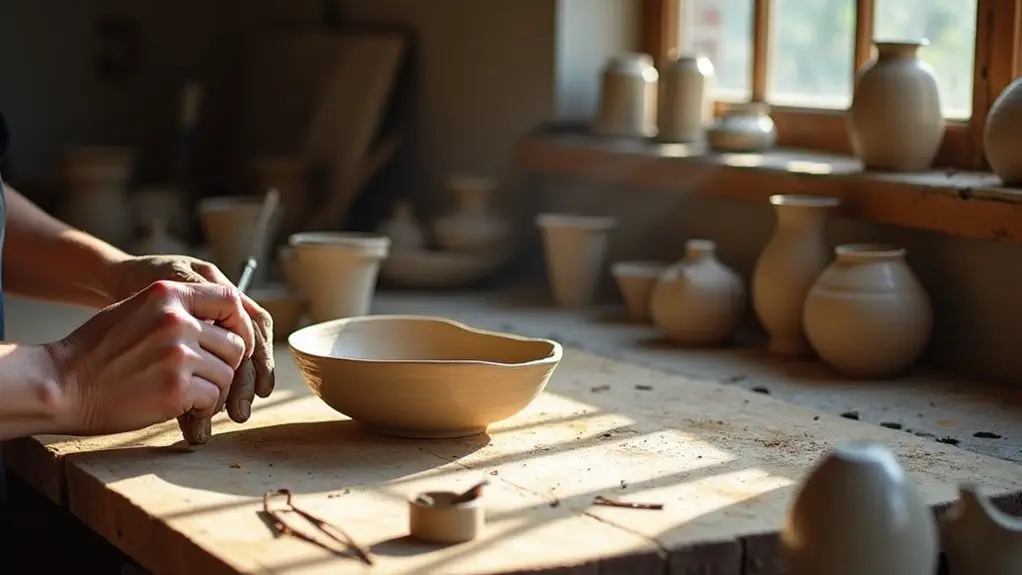
The dedication required to create handmade pottery extends far beyond the potter's wheel. Your time and labor investment directly impacts your pricing strategy, making time tracking essential for sustainable business growth. Since pottery careers typically require 5-8 years to become profitable, setting accurate rates from the start is crucial.
You'll need to carefully monitor your labor efficiency across every stage of creation, from wedging clay to final glazing.
To maximize your pottery business success, focus on these key time-management elements:
- Track time spent on each piece, including prep work and cleanup
- Document your skill-specific hourly rates ($25-$75 based on expertise)
- Monitor efficiency improvements as you develop your craft
Market Research Essentials
Before setting your pottery prices, you'll want to check out what other local potters are charging for similar pieces and study online marketplaces like Etsy to get a feel for current pricing trends. You can gather valuable insights by comparing prices of pieces that match your quality level, size, and style, making sure you're not pricing yourself too high or too low for your market. The growing handmade trend suggests consumers are willing to pay premium prices for unique, non-mass-produced pottery items. Additionally, consider the seasonal use of your products, as items that can be displayed year after year may justify a higher price point. Don't forget to factor in your local market's unique characteristics, as prices can vary considerably between regions and customer demographics.
Local Competitor Price Analysis
Understanding your local competition's pricing structure forms a critical foundation for setting your own pottery prices.
When you analyze local trends and competitor offerings, you'll find handmade ceramics typically range from $20 to $100, with specialized pieces commanding higher prices. Looking at Crooked Tree Ceramics, most handmade sipping cups sell for $26, providing a benchmark for this product category. Your research should focus on similar artisans in your area, like the pricing at Local Nomad Shop, where tumblers sell for $40-$46 and mugs for $58-$60. For example, the Squiggles and Dots Porcelain Ring Holder is a unique piece priced at $15, showcasing how distinct craftsmanship can attract customers.
To stay competitive, you'll want to track these key elements:
- Material quality and craftsmanship levels
- Unique design features and themes (like Arizona-inspired pieces)
- Price tiers across different product categories
Online Marketplace Price Study
Conducting extensive online marketplace research reveals critical insights for pricing your pottery effectively.
When you're studying online selling strategies, don't just look at Etsy market trends – explore multiple platforms to understand the full pricing landscape. You'll want to analyze similar pieces across different marketplaces, noting how prices vary based on quality, size, and artistic details. Some potters aim for a base price model of $12 per pound of wet clay as a starting point.
Start by tracking successful sellers' pricing patterns and note how they adjust for platform-specific fees. If you're seeing mugs selling for $30 on one site but $45 on another, there's probably a good reason!
Remember to factor in each platform's unique costs – Etsy's 6.5% transaction fee might mean you'll need different pricing than on your personal website. This research will help you position your work competitively while maintaining profitability.
Setting Your Base Price
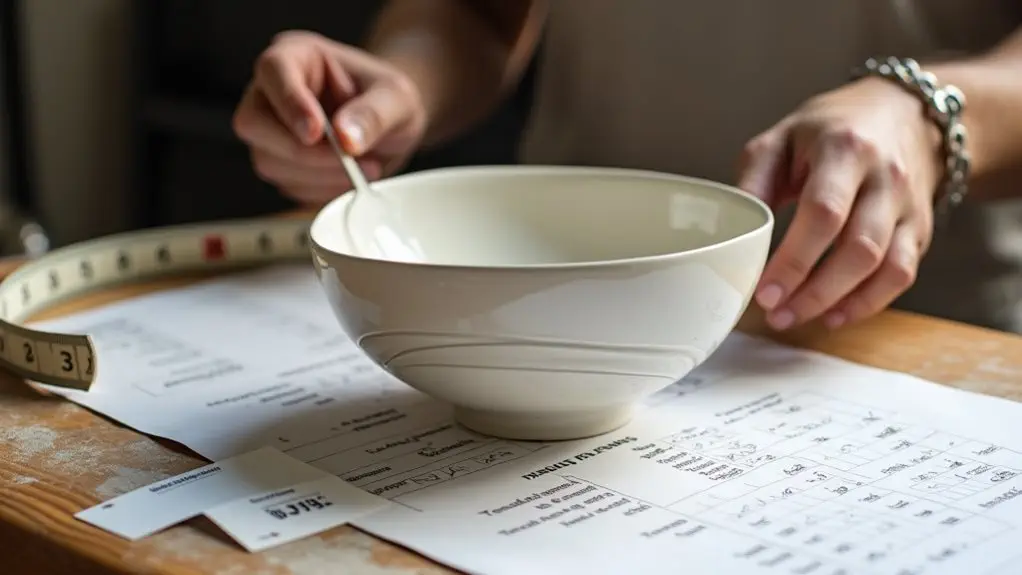
To establish a sustainable pottery business, you'll need a reliable base price that covers your costs while remaining competitive in the market.
Start by calculating your material and labor costs, keeping in mind that customer perception and pricing psychology play vital roles in your success. Testing different sales venues can help you understand how pricing varies across different marketplaces.
Here's a straightforward approach to setting your base price:
- Calculate your materials cost per piece, including clay, glazes, and firing supplies.
- Multiply your hourly rate ($12-$20) by the time spent creating each piece.
- Add these numbers together and double it for your initial markup.
Remember that you're not just selling pottery – you're selling your expertise, creativity, and unique artistic vision.
Don't undervalue your work! You can always adjust your prices based on market response, but starting with a solid base price guarantees you'll cover your costs and maintain room for growth.
Overhead and Operating Expenses
Beyond your base price calculations, overhead and operating expenses greatly impact your pottery business's financial health.
Your overhead breakdown should include studio essentials like rent, utilities, and those ever-hungry kilns that seem to devour electricity. Monthly expense tracking helps identify areas where costs can be reduced.
Don't forget about your trusty equipment – from wheels to pug mills – which need regular maintenance and eventually replacement.
Smart expense management means tracking everything from your website costs to those seemingly small Etsy fees that add up quickly.
You'll need to factor in business operations like marketing, professional development, and those essential shipping supplies (because nobody wants their pottery arriving in pieces!).
Artistic Value Assessment
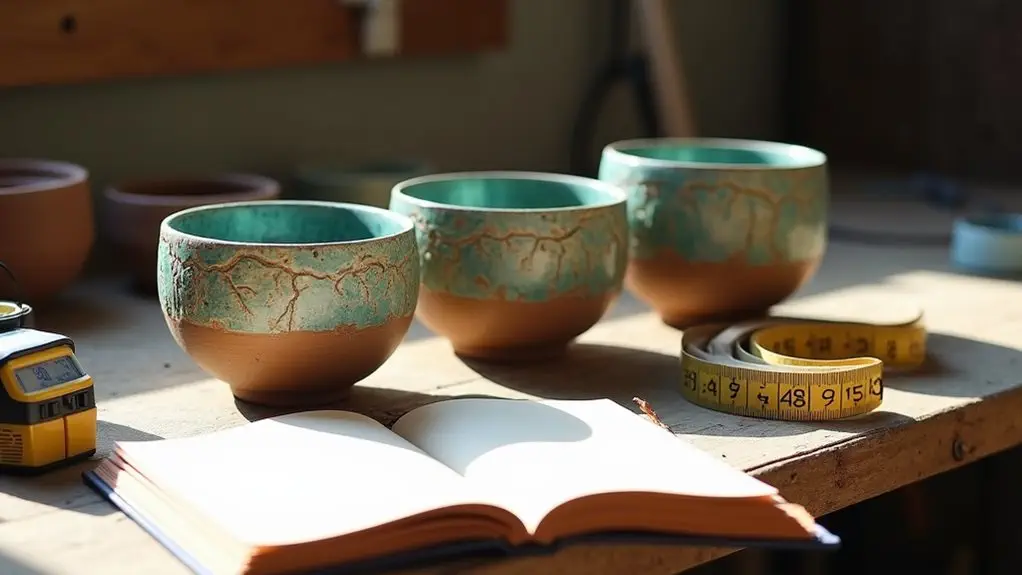
Artistic value stands at the heart of pricing handmade pottery effectively. When you're determining your piece's worth, you'll need to evaluate how your artistic techniques and historical provenance contribute to its market value.
Professional appraisals and expert opinions can help you understand where your work fits in today's marketplace. The appeal of specific types and distinctive glazes significantly impacts perceived value, particularly in pieces like Roseville and Watt pottery.
Here are three key factors that'll boost your pottery's artistic value:
- Unique craftsmanship that showcases innovative techniques or distinctive style
- Well-documented history of your work, including exhibitions or awards
- Strong artistic reputation in your market niche
You'll want to regularly reassess your pricing as your skills grow and market demands shift.
Profit Margin Strategies
To build a sustainable pottery business, you'll need to calculate your minimum markup by factoring in all your costs, including materials, time, and overhead expenses.
You're not just creating beautiful pieces; you're running a business that needs to generate enough profit to keep your wheels turning and your kiln firing. Consider that studio rental fees will significantly impact your overall pricing structure.
Whether you're selling through galleries, craft fairs, or online platforms, aim for a markup of at least 100% on your baseline costs to guarantee you've got room for wholesale opportunities and unexpected expenses.
Calculating Minimum Markup Needed
When establishing prices for handmade pottery, you'll need to calculate your minimum markup carefully to guarantee profitability. Your cost analysis should include everything from raw materials to firing time, ensuring you've captured all expenses in your markup strategies.
To determine your minimum markup, focus on these essential components:
- Calculate your total materials cost, including clay, glazes, and tools.
- Track your time and set a fair hourly rate for your expertise.
- Factor in overhead costs like electricity, kiln maintenance, and studio space.
You'll want to aim for at least a 40% profit margin to keep your pottery business sustainable. With proper pricing strategies and market demand, you can achieve revenue of six figures annually through your pottery business.
Setting Sustainable Price Points
Setting sustainable price points requires a delicate balance between profitability and market acceptance.
You'll want to aim for a profit margin between 40-60% while considering sustainable sourcing practices and ethical pricing strategies that reflect your commitment to quality craftsmanship.
Start by analyzing your total costs, including materials, studio expenses, and labor, then add your desired profit margin. Regular monitoring of expenses and revenue will help you maintain healthy profit margins of 8-30% in line with industry standards.
Don't forget to factor in market research – what're other potters charging for similar pieces?
You're not just selling pottery; you're selling your unique artistic vision and expertise.
Consider creating different price tiers to appeal to various customer segments while maintaining your brand's integrity.
Pricing Across Different Sales Channels
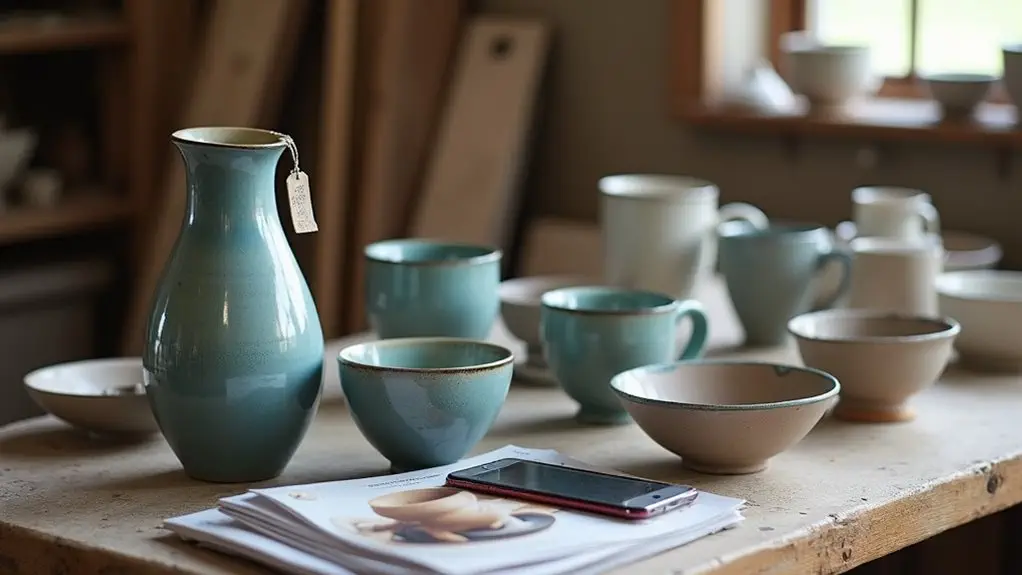
Maintaining consistent prices across different sales channels poses a unique challenge for pottery artists. Each piece, much like the unique character of Cheeky Porcelain Pumpkins, is crafted with individuality in mind, making it essential to reflect that uniqueness in your pricing strategy. You'll need to develop smart sales channel strategies that account for various commission rates and fees while keeping your pricing consistency intact. Whether you're selling through galleries, online platforms, or local markets, it's vital to maintain uniform pricing to build trust with your customers. A profit margin range of 5% to 20% should be factored into your base pricing calculations.
Here are three key factors to take into account when pricing across channels:
- Gallery commissions (30-60% of sale price)
- Online marketplace fees (Etsy, website hosting)
- Packaging and shipping costs for each channel
You'll want to calculate your base price with these factors in mind, ensuring you're profitable regardless of where you sell and that your handmade pieces, like unique ceramics, retain their value in the marketplace.
Seasonal and Collection Pricing
Successful pottery pricing requires a dynamic approach that adapts to seasonal market changes and collection strategies.
When you're tracking seasonal trends, you'll notice that holiday periods can command higher prices, while off-season times might need strategic discounts to maintain steady sales. Additionally, featuring collections like the Butterfly Ring Holder can attract attention during these peak times.
Your collection diversity plays an essential role in pricing strategy. Maintaining cost-plus pricing methods ensures you cover materials and achieve profitable margins. Consider creating tiered pricing within your collections to appeal to different budgets, and don't forget to factor in the artistic value of your more complex pieces.
You can boost your pricing power by introducing limited edition seasonal items that capitalize on scarcity. The unique design of pieces like the Serenity Garden Porcelain Butterfly Jewellery Holder enhances their overall appeal.
By studying similar products in galleries and online platforms like Etsy, you'll develop a keen sense of where your pieces fit in the market.
Final Thoughts
Remember, "Rome wasn't built in a day," and neither is your pottery pricing strategy. You'll need to continually adjust your prices as you gain experience and market insight. By carefully considering your costs, time investment, and artistic value, you're now equipped to price your handmade pottery confidently. Trust your instincts, but don't forget to stay flexible and responsive to your customers' feedback and market demands.

